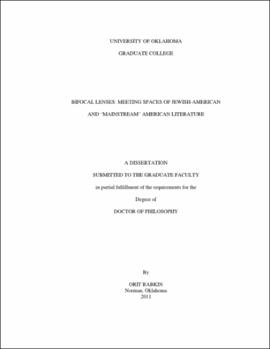| dc.contributor.advisor | McDonald, William H||Sawaya, Francesca | |
| dc.creator | Rabkin, Orit | |
| dc.date.accessioned | 2019-04-27T21:37:17Z | |
| dc.date.available | 2019-04-27T21:37:17Z | |
| dc.date.issued | 2011 | |
| dc.identifier | 99351927302042 | |
| dc.identifier.uri | https://hdl.handle.net/11244/319177 | |
| dc.description.abstract | This dissertation critically examines the concept of Jewish-American literary hyphenation, analyzing its historical and theoretical consequences (chapters one and two), then applying the results of that analysis to three pairs of texts: Mary Antin's The Promised Land (1912) and George Eliot's Daniel Deronda (1876) (chapter three); Abraham Cahan's The Rise of David Levinsky (1917) and William Dean Howells' The Rise of Silas Lapham (1885) (chapter four); and Anzia Yezierska's Salome of the Tenements (1923) and John Dewey's Democracy and Education (1916) (Chapter five). My thesis is that Jewish-American writers working at the turn of the twentieth century negotiated a space for themselves inside of the American literary mainstream and that their reception currently continues to be defined by confining systems of literary hyphenation. | |
| dc.format.extent | 262 pages | |
| dc.format.medium | application.pdf | |
| dc.language | en_US | |
| dc.relation.requires | Adobe Acrobat Reader | |
| dc.subject | American literature--Jewish authors--History and criticism | |
| dc.subject | American literature--19th century--History and criticism | |
| dc.subject | American literature--20th century--History and criticism | |
| dc.title | BIFOCAL LENSES: MEETING SPACES OF JEWISH-AMERICAN AND "MAINSTREAM" AMERICAN LITERATURE | |
| dc.type | text | |
| dc.type | document | |
| dc.thesis.degree | Ph.D. | |
| ou.group | College of Arts and Sciences::Department of English | |
